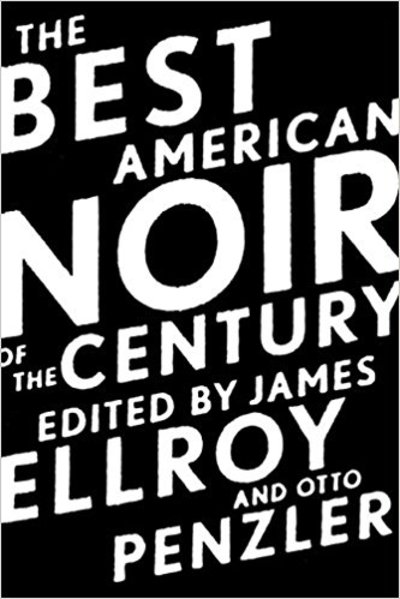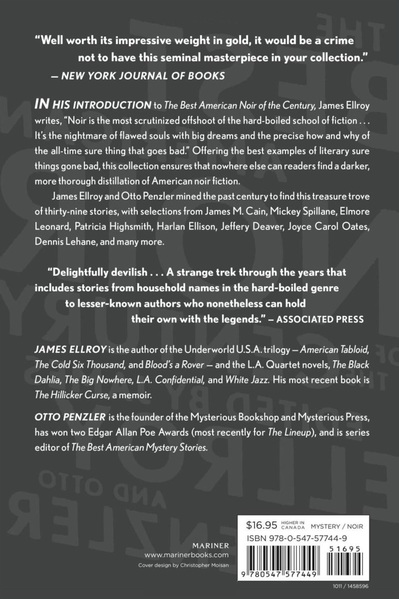A Glimpse of the Secret Pervert Republic: The Best American Noir of the Century, edited by James Ellroy and Otto Penzler
 |
 |
I’ve recently been enjoying the massive 2011 anthology The Best American Noir of the Century, which isn’t science fiction or fantasy, but which does showcase a lot of highly regarded SF and fantasy writers, including Charles Beaumont, Cornell Woolrich, Harlan Ellison, David Morrell, and others.
The first question I had when I set set eyes on this book was “Which century are they talking about?” Turns out it’s neither the 20th nor the 21st… it’s the last hundred years, give or take. The book includes 39 stories arranged chronologically by publication date, starting with Tod Robbins “Spurs,” which first appeared in Munsey’s Magazine in February 1923, and ending with Lorenzo Carcaterra’s “Missing the Morning Bus,” from Penzler’s 2007 anthology of poker stories, Dead Man’s Hand.
Penzler gives a nice overview of the history of noir fiction in his Foreword, but it’s Ellroy’s introduction, in which he claims that American noir describes “the demography of a Secret Pervert Republic” that I found especially entertaining. Here’s a few snippets.
First, from Penzler’s foreword:
This volume is devoted to short noir fiction of the past century, but it is impossible to divorce the literary genre entirely from its film counterpart. Certainly, noir most commonly evokes the great crime films of the 1940s and 1950s that were shot in black-and-white with cinematography that was heavily influenced by early-twentieth-century German expressionism: sharp angles (venetian blinds, windows, railroad tracks) and strong contrasts between light and dark. Most of us have a collective impression of film noir as having certain essentials: a femme fatale, some tough criminals, an equally tough cop or private eye, an urban environment, and night… endless night. There are bars, nightclubs, menacing alleys, seedy hotel rooms.
While it may be comforting to recognize these elements as the very definition of film noir, it is as simplistic a view as that which limits the mystery genre to detective fiction, failing to accept the numerous other elements of that rich literature, such as the crime novel and suspense stories…
This massive collection seldom allows exceptions to these fundamental principles of noir stories. They are dark and often oppressive, failing to allow redemption for most of the people who inhabit their sad, violent, amoral world. Carefully wrought plans crumble, lovers deceive, normality morphs into decadence, and decency is scarce and unrewarded. Nonetheless, the writers who toil in this oppressive landscape have created stories of such relentless fascination that they rank among the giants of the literary world. Some, like Cornell Woolrich, David Goodis, and Jim Thompson, wrote prolifically but produced little that did not fall into the noir category, accurately reflecting their own troubled, tragic lives. Others, like Elmore Leonard, Evan Hunter, and Lawrence Block, have written across a more varied range of crime fiction, from dark to light, from morose to hilarious. Just not in this volume. If you find light and hilarity in these pages, I strongly recommend a visit to a mental health professional.
And Ellroy’s introduction.
Noir sparked before the Big War and burned like a four-coil hot plate up to 1960. Cheap novels and cheap films about cheap people ran concurrent with American boosterism and yahooism and made a subversive point just by being. They described a fully existing fringe America and fed viewers and readers the demography of a Secret Pervert Republic…
The inhabitants of the Secret Pervert Republic are a gas. Their intransigence and psychopathy are delightful. They relentlessly pursue the score, big and small. They only succeed at a horrific cost that renders it all futile. They are wildly delusional and possessed of verbal flair. Their overall job description is “grandiose lowlife.” They speak their own language. Safecrackers are “boxmen” who employ explosive “soup.” Grifters perfect the long con, the short con, and the dime hustle. Race-wire scams utilize teams of scouts who place last-minute bets and relay information to bookmaking networks. A twisted professionalism defines all strata of the Secret Pervert Republic. This society grants women a unique power to seduce and destroy. A six-week chronology from first kiss to gas chamber is common in noir.
The subgenre officially died in 1960. New writer generations have resurrected it and redefined it as a sub-subgenre, tailored to meet their dramatic needs. Doom is fun. Great sex preceded the gas-chamber bounce. Older Secret Pervert Republicans blew their wads on mink coats for evil women. Present-day SPRs go broke on crack cocaine. Lethal injection has replaced the green room. Noir will never die — it’s too dementedly funny not to flourish in the heads of hip writers who wish they could time-trip to 1948 and live postwar malaise and psychoses. The young and feckless will inhabit the Secret Pervert Republic, reinvent it, wring it dry, and reinvent it all over again.
The short stories in this volume are a groove. Exercise your skeevy curiosity and read every one. You’ll be repulsed and titillated. You’ll endure moral forfeit. Doom is fun. You’re a perv for reading this introduction. Read the whole book and you’ll die on a gurney with a spike in your arm.
Read the complete foreword and introduction to The Best American Noir of the Century here, and a lengthy review of the entire volume at Pop Matters.
Here’s the complete TOC.
“Spurs,” Tod Robbins
“Pastorale,” James M. Cain
“You’ll Always Remember Me,” Steve Fisher
“Gun Crazy,” MacKinlay Kantor
“Nothing to Worry About,” Day Keene
“The Homecoming,” Dorothy B. Hughes
“Man in the Dark,” Howard Browne
“The Lady Says Die!,” Mickey Spillane
“Professional Man,” David Goodis
“The Hunger,” Charles Beaumont
“The Gesture,” Gil Brewer
“The Last Spin,” Evan Hunter
“Forever After,” Jim Thompson
“For the Rest of Her Life,” Cornell Woolrich
“The Dripping,” David Morrell
“Slowly, Slowly in the Wind,” Patricia Highsmith
“Iris,” Stephen Greenleaf
“A Ticket Out,” Brendan DuBois
“Since I Don’t Have You,” James Ellroy
“Texas City,” James Lee Burke
“Mefisto in Onyx,” Harlan Ellison
“Out There in the Darkness,” Ed Gorman
“Hot Springs,” James Crumley
“The Weekender,” Jeffery Deaver
“Faithless,” Joyce Carol Oates
“Poachers,” Tom Franklin
“Like a Bone in the Throat,” Lawrence Block
“Crack,” James W. Hall
“Running out of Dog,” Dennis Lehane
“The Paperhanger,” William Gay
“Midnight Emissions,” F.X. Toole
“When the Women Come Out to Dance,” Elmore Leonard
“Controlled Burn,” Scott Wolven
“All Through the House,” Christopher Coake
“What She Offered,” Thomas H. Cook
“Her Lord and Master,” Andrew Klavan
“Stab,” Chris Adrian
“The Hoarder,” Bradford Morrow
“Missing the Morning Bus,” Lorenzo Carcaterra
The Best American Noir of the Century was published in hardcover by Houghton Mifflin Harcourt on October 5, 2010, and reprinted by Mariner Books on October 4, 2011. It is 731 pages, priced at $18.99 in trade paperback and $9.99 for the digital edition.
See all of our recent Book coverage here.
“does showcase a lot of highly regarded SF and fantasy writers”
This is my argument for why we should include reviews of Hard Case Crime novels on Blackgate!
James,
If you’ve got a review, I’m game!
I’ve got this Del Rey Best of thing going right now. But I will keep it in mind.
In all seriousness, I think Scott Lynch’s gentlemen bastards series is a crossover of fantasy and something like Ocean’s 11. Though not quite noir, I think it shows some continuity with the genre. Perhaps a better fantasy example, especially in terms of tone similar to noir, is Moorcock’s eternal champion stuff, particularly the Elric series. There’s a lot of existential angst in Moorcock that reminds me of noir.
The Hard Case Crime novels are actually a nice mix of noir, comedy, mystery and detective works. The comedy volumes are some of the funniest things I’ve read in years.
I’ve always thought that sword & sorcery had a lot in common with noir and with westerns (especially the more Man-With-No-Name sorts) in terms of structure & tone.
Glen Cook has written a veritable plethora of Garrett, P.I. books, which are basically noir mysteries set in a secondary world complete with elves and dwarves.
And sigh, yes, it looks like this anthology needs to be added to the Infinitely-Expansible TBR Pile.
This looks well worth picking up. I’ve written elsewhere that Westerns, hardboiled, noir, and swords & sorcery have a whole lot in common – lone wolves facing a corrupt, deadly world